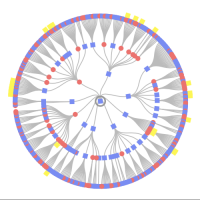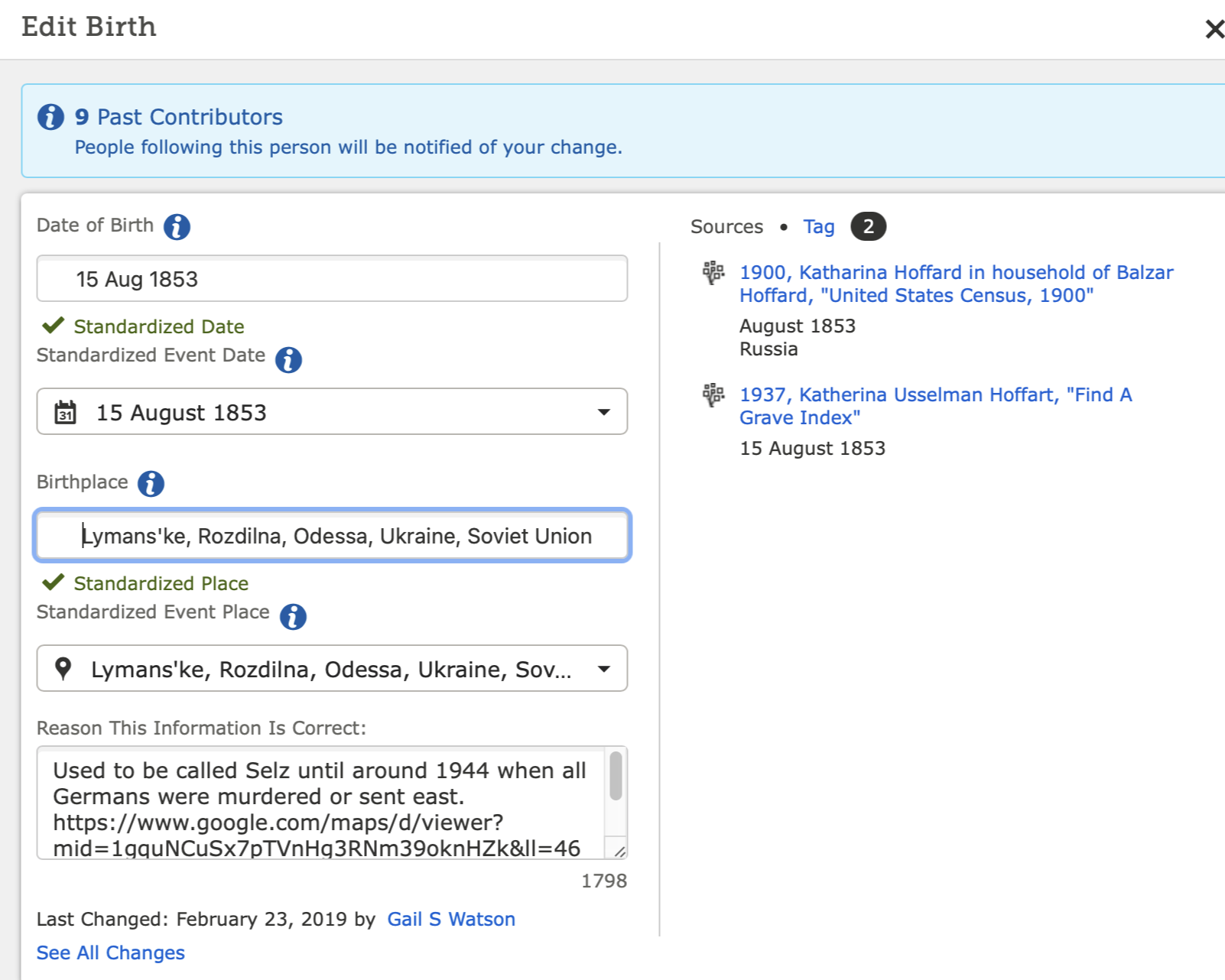Why would a birth place be displaying as the wrong country?
Answers
-
Regarding the historic surnames, that again shows the great skills of the FamilySearch design team. Some of my wife's relatives have six to ten alternate names under Other Information. Since the search engine looks at all of the alternate name on a person in addition to the name in the Vitals section, a person can be found no matter which name a user uses to search for them.
Regarding place names:
This place name is perfectly legal, fully acceptable, fully standardized, free of any red exclamation point, and makes full use of the intentional design of Family Tree.
There are some limits that I have not fully figured out on what can be entered and still standardize a name, and I'm not sure you can really use all 256 characters, but we still have been given a flexibility that far outstrips any other paper form or genealogy program that I have ever run across.
0 -
@Gordon Collett I don't have that in the Edit Birth options.
1 -
Gail, if you put your cursor in the birthplace field and press the space bar, a pull-down menu will appear.
Personally, I do not like to introduce discrepancies between the displayed place and the standardized place. I spend a lot of time correcting the selection of standardized places and when the displayed place is not a standard, I do not know if the standardized place is correct so I spend (waste) time checking. Very often the standardized place is wrong, sometimes other-side-of-the-planet wrong!
For that reason I prefer to edit the displayed place so it matches the most appropriate standardized place. Or, if "none of the above" is appropriate, I edit the displayed place to what it should be, select the standard place None of the above and leave in the reason field a note that a standardized place needs to be added to the Places gazetteer. This causes a red flag, which is entirely appropriate.
Often, but not always, I also take the time to begin the process of adding the place to the Places gazetteer.
1 -
Looking at the gazetteer, I see two relevant places, both lacking sufficient time period delimiters:
Lymans'ke
Rozdilna, Odessa, Ukraine
Populated Place, Unknown - Today
Alternate Name: Selz
Lymans'ke
Rozdilna, Odessa, Ukraine, Soviet Union
Populated Place, Unknown - Today
Alternate Name: Selz
Each has a page in the gazetteer, with an edit button labeled "Improve this place". That is where you can request the addition of start and end dates and other information.
See for example https://www.familysearch.org/research/places/?searchTypeaheadInputText=selz&text=selz&focusedId=9125554
0 -
For completeness, I should also point out that FamilySearch has given us the same flexibility in entering dates. We don't need to hide information in notes or reason statements or other places other people may never bother looking. We can put it right where it is obvious. The following date entry is also correct usage of one of the great features of the Family Tree:
If you would like to have more information about my views on place names and place name standards, how they work, and the actual process of the three different ways to enter places names, and have twenty minutes to waste, you might be interested in this: https://community.familysearch.org/en/discussion/110347/the-places-database-and-entering-place-names-in-family-tree It will also show you why and when that second place name box appears and how to use it.
The reason I make such widespread usage of this feature for entering place names as I do, in contrast to dontiknowyou, is that my wife and I are mainly working on her family in Norway and in that country well over 90% of the place name standards are incomplete, missing, or wrong. The initial database FamilySearch used to create the standards for there was not very good. They are working on improving the portion of the database that covers Norway but it will probably take a couple of decades. Norway is just not a very big part of the world, they don't have many people working on it (three that I'm aware of), and they have other much more important things to be working on since we can still enter the place names correctly and link them to a close enough standard.
1 -
If a location is not standardized, it will be corrected by someone eventually and probably changed to something REALLY wrong. I have seen lots of corrections. And if I type in Selz, Odessa, Russian Empire (which is what I think it should be), someone will come along and change it to Selz for the wrong country (which is how this thread started). There is no Selz for the Russian Empire. I tried the add a place, per your suggestion, but I don't know the historic name of the province (now the province is Odessa), so I can't get past that point. I didn't realize the province name is just as modern as the village name. Even though I have introduced a discrepancy between the standardized place and the correct historic place, all the information is there for researchers. The standardized place goes to the exact location my husband's ancestors were walking around 200-150 years ago.
0 -
The point is, you can always standardize it correctly. So if the name as displayed is completely correct, and the linked standard puts it on the right place on the map, and there is no red exclamation point, there is no reason for anyone to ever make any change to the place name.
Ideally, when the Places database is complete, it will include all significant historic names for all places and you will be able to look up the name there, cutting down the time needed for you to research it on your own.
0






